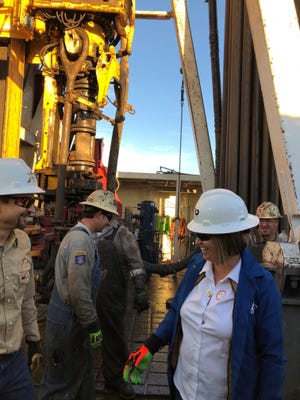Oil and gas was a precious commodity in New Mexico for decades, generating billions of dollars in revenue for the state each year.
Amid the COVID-19 pandemic, the value of fossil fuels to New Mexico remained unchanged as the State Land Office reported continued high levels of production and revenue from extraction on state land.
Land continued to be leased to operators in monthly sales as operations focused on the Permian Basin region to the southeast.
But New Mexico Commissioner of Public Lands Stephanie Garcia Richard said the resource was “finite” and would run out eventually.
More:U.S. Senate votes to restore federal oil and gas methane rules after Heinrich resolution

To her, that meant New Mexico’s economy and use of its State-owned public land needed to diversify.
Garcia Richard said oil and gas leasing of State Trust land recently began to use up most of the “choice” or ideal tracts of land over the best geological formations in the basin which is known as one of the world’s most prolific resources for fossil fuel development.
More:U.S. Rep Yvette Herrell calls for New Mexico to oppose Biden’s oil and gas policies
Of about 1.6 million acres still open for lease in the Permian, the State Land Office reported 1.4 million acres were not “choice” land that would sell at top market price.
That’s likely why the Office’s April State Trust land lease sale in April 2019 brought in about $1.3 million in bids, Land Office records show, while the April 2021 sale only generated $361,916 in bids.
It’s not because of a decline in demand for the land, Garcia Richard said, as the April 2019 sale offered up less land at 878 acres compared with 2,018 this year.
More:BLM cancels oil and gas leases for second quarter of 2021. New Mexico could lose millions
Tracts of land are typically nominated by oil and gas companies based on where they want to drill, but based on their location they might not bring a higher price.
“Not only do we have fewer choice tracts, but we also have less tracts,” Garcia Richard said. “The amount of tracts we’re able to put out are getting lower and their quality is not as good.”
It’s also not indicative of slowing production, she said.
During her tenure since taking office in 2019, Garcia Richard said the Land Office had the three biggest months of royalties from oil and gas production in its history, all within the last year and a half.
More:U.S. Sen. Ben Ray Lujan looks for federal funds to plug abandoned oil and gas wells
February 2020 brought in $108 million in royalties, she said, with $106 million generated in April 2020.
April 2021 was anticipated to net $109 million in royalties, records show.
“From the production side we are not seeing a decline in demand. What we’re seeing more is we have fewer and fewer of the really choice parcels available for lease,” Garcia Richard said. “
More:Texas company seeks to capitalize on Permian Basin oil and gas’ recovery from COVID-19
In the Permian is the choice place to be. Some other places are nearby but they’re not really in the sweet spot of that geological formation in the Permian. Our production numbers are still breaking records.”
But the high levels of oil and gas production and compliance with state law do not have to be mutually exclusive, Garcia Richard said.
While her office continued to see higher and higher levels of production on state land, she said it was also prioritizing remediating land no longer used for oil and gas operations and holding companies accountable for cleanup responsibilities.
More:Permian Basin oil and gas nearing pre-pandemic production levels. Companies seek to cash in

“I like to think that we believe there is an ability to preside over record breaking growth in the industry while also making meaningful change and holding the industry accountable,” she said. “We’re able to get a lot more acreage cleaned up and wells plugged. We’re also working with industry.”
Recently, the State Land Office discovered an area in McKinley County where operators left at least 29 wells unplugged and failed to remediate 500 acres of State Trust land.
The Land Office filed a lawsuit against BC&D Operating and Dominion Production Company, hoping to compel the defendants in court to follow state law and cleanup the site on two State Land Office leases and pay penalties dating back to 2018.
More:New Mexico activists call for oil and gas reform amid Biden’s review of federal policy
Since the Office launched its Accountability and Enforcement Program six months ago, it filed 16 such lawsuits and fully reclaimed 12 contaminated, abandoned sites across the state.
“A lot of companies are proving willing to work with the State Land Office to clean up abandoned well sites,” Garcia Richard said. “At the other end of the spectrum, we are taking decisive legal action against companies who walk away from their messes and responsibilities to the land.”
Diversification and a low-carbon future
Changing tides in federal and state government could also lead to the growing production numbers, Garcia Richard said, as a shift toward a renewed focus on decrease carbon footprints was outlined in President Joe Biden’s agenda as he took office earlier this year and observed in the New Mexico’s 2021 Legislative Session.
More:‘Community solar’ becomes law in New Mexico, to help shift away from oil and gas
“I’m hearing that folks are really wanting to drill while they can. I don’t know if that’s pressure from the federal actions. It could be,” Garcia Richard said.
Even as production numbers grew, the Office had an eye toward diversifying the use of State Trust land to ensure it could be fiscally viable into the future, continuing to generate dollars even after fossil fuels were no more.
“From our perspective, we don’t believe this kind of historic production will continue forever. For us, it’s more about what then? Once we have the drawdown of revenue that we get from the Permian, how do we replace it?” Garcia Richard said.
“We need a diversification strategy to raise revenue to take the place of oil and gas once it starts to ramp down. It’s finite. I don’t know why that’s a bogeyman thing to say. The ultimate downturn will hit our state budget hard, so we need to plan for that.”
More:Energy secretary called on to consider impact on New Mexico, oil and gas of federal policy
Expanding State Trust land beyond oil and gas means leases for uses like renewable energy, outdoor recreation, technology companies, even defense contractors and cyber security, Garcia Richard said.
She said her goal was to triple power generated by renewable sources on State Trust land, having already doubled it from 453 megawatts to 919 in the last two years and establishing the State Land Office’s first Office of Renewable Energy to recruit developers in sectors like wind and solar power.
In March, the Office announced the first-ever municipal energy utility leases with the City of Las Cruces for four solar projects generating about 2.2 megawatts of power each year with the City paying about $20,000 annually to the Land Office for the use of about 10 acres of State Trust land.
More:EOG Resources using solar power for natural gas facilities as New Mexico fights pollution
“This project moves us one step closer to an independent resilient system that can utilize clean energy to supply another vital resource, water, through the wells serving our residents,” said Las Cruces City Councilor Gill Sorg in a statement. “Wise management of both of these systems supports the City and State’s sustainability goals.”
The State Land Office in January approved a four-year easement to give hunters and fishers access to about 9 million acres of State Trust land in a deal that saw the New Mexico Department of Game and Fish pay $800,000 annually to the Land Office while also agreeing to spend $200,000 on projects to improve access to such activities.
New Mexico Game Commission Chair Jeremy Vesbach said the deal would see more New Mexicans having access to the outdoors.
“One of the values we share with the State Land Office is the ability to get our families outside,” he said. “One thing this pandemic has shown us is how important outdoor recreation and our ties to the land is. This easement shows that and expands opportunities to camp and get outside. I’m excited for this easement.”
Projects like those are part of the State’s preparation for the ultimate end of oil and gas, Garcia Richard said, and ensuring oil and gas communities are not left behind.
“It makes sense to me that people in Carlsbad would be wary of people in public office not being supportive,” she said. “We’re talking about people’s paychecks. There is economic opportunity and jobs opportunity even in the winding down (of oil and gas).”
Adrian Hedden can be reached at 575-618-7631, achedden@currentargus.com or @AdrianHedden on Twitter.







